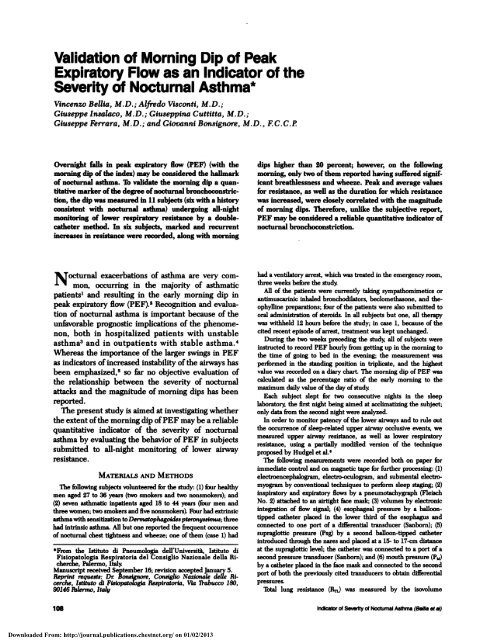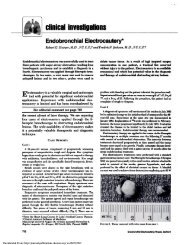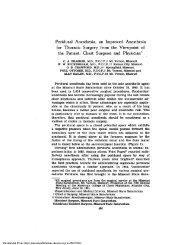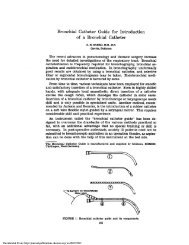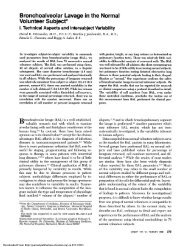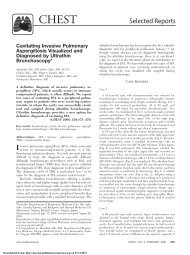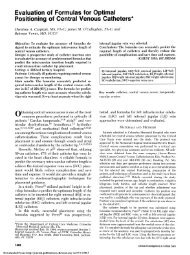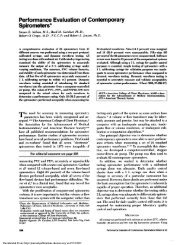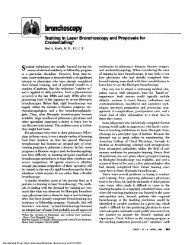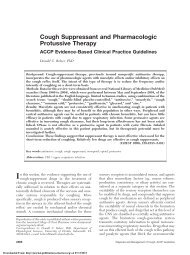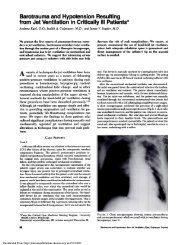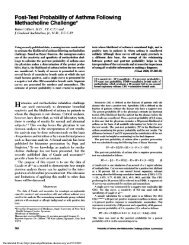Validation of Morning Dip of Peak Flow as an Indicator of the ... - Chest
Validation of Morning Dip of Peak Flow as an Indicator of the ... - Chest
Validation of Morning Dip of Peak Flow as an Indicator of the ... - Chest
You also want an ePaper? Increase the reach of your titles
YUMPU automatically turns print PDFs into web optimized ePapers that Google loves.
<strong>Validation</strong> <strong>of</strong> <strong>Morning</strong> <strong>Dip</strong> <strong>of</strong> <strong>Peak</strong><br />
Expiratory <strong>Flow</strong> <strong>as</strong> <strong>an</strong> <strong>Indicator</strong> <strong>of</strong> <strong>the</strong><br />
Severity <strong>of</strong> Nocturnal Asthma*<br />
Vincenzo Bellia, M.D.; Aifredo Visconti, M.D.;<br />
Gluseppe Insalaco, M.D.; Giuseppina Cuttitta, M.D.;<br />
Giuseppe Ferrara, M.D.; <strong>an</strong>d Giov<strong>an</strong>ni Bonsignore, M.D., F.C.C.P<br />
Overnight falls in peak expiratory flow (PEF) (with <strong>the</strong><br />
morning dip <strong>of</strong> <strong>the</strong> index) may be considered <strong>the</strong> hallmark<br />
<strong>of</strong> nocturnal <strong>as</strong>thma. To validate <strong>the</strong> morning dip a qu<strong>an</strong>titative<br />
marker <strong>of</strong><strong>the</strong> degree <strong>of</strong>nocturnal bronchoconstriclion,<br />
<strong>the</strong> dip w<strong>as</strong> me<strong>as</strong>ured in 11 subjects (six with a history<br />
consistent with nocturnal <strong>as</strong>thma) undergoing all-night<br />
monitoring <strong>of</strong> lower respiratory resist<strong>an</strong>ce by a doubleca<strong>the</strong>ter<br />
method. In six subjects, marked <strong>an</strong>d recurrent<br />
incre<strong>as</strong>es in resist<strong>an</strong>ce were recorded, along with morning<br />
N octurnal exacerbations <strong>of</strong> <strong>as</strong>thma are very common,<br />
occurring in <strong>the</strong> majority <strong>of</strong> <strong>as</strong>thmatic<br />
patients’ <strong>an</strong>d resulting in <strong>the</strong> early morning dip in<br />
peak expiratory flow (PEF).2 Recognition <strong>an</strong>d evalua-<br />
tion <strong>of</strong> nocturnal <strong>as</strong>thma is import<strong>an</strong>t because <strong>of</strong> <strong>the</strong><br />
unfavorable prognostic implications <strong>of</strong> <strong>the</strong> phenome-<br />
non, both in hospitalized patients with unstable<br />
<strong>as</strong>thma3 <strong>an</strong>d in outpatients with stable <strong>as</strong>thma.4<br />
Where<strong>as</strong> <strong>the</strong> import<strong>an</strong>ce <strong>of</strong> <strong>the</strong> larger swings in PEF<br />
<strong>as</strong> indicators <strong>of</strong>incre<strong>as</strong>ed instability <strong>of</strong><strong>the</strong> airways h<strong>as</strong><br />
been emph<strong>as</strong>ized,5 so far no objective evaluation <strong>of</strong><br />
<strong>the</strong> relationship between <strong>the</strong> severity <strong>of</strong> nocturnal<br />
attacks <strong>an</strong>d <strong>the</strong> magnitude <strong>of</strong> morning dips h<strong>as</strong> been<br />
reported.<br />
The present study is aimed at investigating whe<strong>the</strong>r<br />
<strong>the</strong> extent <strong>of</strong><strong>the</strong> morning dip <strong>of</strong>PEF may be a reliable<br />
qu<strong>an</strong>titative indicator <strong>of</strong> <strong>the</strong> severity <strong>of</strong> nocturnal<br />
<strong>as</strong>thma by evaluating <strong>the</strong> behavior <strong>of</strong> PEF in subjects<br />
submitted to all-night monitoring <strong>of</strong> lower airway<br />
resist<strong>an</strong>ce.<br />
MATERIALS AND METhODS<br />
The following subjects volunteered for <strong>the</strong> study: (1) four healthy<br />
men aged 27 to 36 years (two smokers <strong>an</strong>d two nonsmokers); <strong>an</strong>d<br />
(2) seven <strong>as</strong>thmatic Inpatients aged 18 to 44 years (four men <strong>an</strong>d<br />
three women; two smokers <strong>an</strong>d five nonsmokers). Four had extrinsic<br />
<strong>as</strong>thmawith sensitization toDerinatophagoidespteronyssimus; three<br />
had intrinsic <strong>as</strong>thma. All but one reported <strong>the</strong> frequent occurrence<br />
<strong>of</strong> nocturnal chest tightness <strong>an</strong>d wheeze; one <strong>of</strong> <strong>the</strong>m (c<strong>as</strong>e 1) had<br />
*From <strong>the</strong> ISfitUtO di Pneumologla dell’Unlversit#{224}, Istituto di<br />
Flsiopatolngia Respiratoria del Consigilo Nazionale della Richerche,<br />
Palermo, Italy<br />
M<strong>an</strong>uscript received September 16; revIsion accepted J<strong>an</strong>uary 5.<br />
Reprint requests: Dr Bonaignore, Consiglio Nazionale delis RIcerche,<br />
Istituto di FISIOpatOIOgIa Respiratoria, Via Trabucco 180,<br />
90146 Ihlermo, Italy<br />
dips higher th<strong>an</strong> 20 percent; however, on <strong>the</strong> following<br />
morning, only two <strong>of</strong> <strong>the</strong>m reported having suffered signific<strong>an</strong>t<br />
breathlessness <strong>an</strong>d wheeze. <strong>Peak</strong> <strong>an</strong>d average values<br />
for resist<strong>an</strong>ce, <strong>as</strong> well <strong>as</strong> <strong>the</strong> duration for which resist<strong>an</strong>ce<br />
w<strong>as</strong> incre<strong>as</strong>ed, were closely correlated with <strong>the</strong> magnitude<br />
<strong>of</strong> morning dips. Therefore, unlike <strong>the</strong> subjective report,<br />
PEF may be considered a reliable qu<strong>an</strong>titative indicator <strong>of</strong><br />
nocturnal bronchoconstriction.<br />
had a ventilatory arrest, which w<strong>as</strong> treated in <strong>the</strong> emergency room,<br />
three weeks before <strong>the</strong> study.<br />
All <strong>of</strong> <strong>the</strong> patients were currently taldng sympathomimetics or<br />
<strong>an</strong>timuscarinic inhaled bronchodilators, beclometh<strong>as</strong>one, <strong>an</strong>d <strong>the</strong>ophylline<br />
preparations; four <strong>of</strong> <strong>the</strong> patients were also submitted to<br />
oral administration <strong>of</strong> stemicla In all subjects but one, all <strong>the</strong>rapy<br />
w<strong>as</strong> withheld 12 hours before <strong>the</strong> study; in c<strong>as</strong>e 1, because <strong>of</strong> <strong>the</strong><br />
cited recent episode <strong>of</strong>arrest, treatment w<strong>as</strong> kept unch<strong>an</strong>ged.<br />
During <strong>the</strong> two weeks preceding <strong>the</strong> study all <strong>of</strong> subjects were<br />
instructed to record PEF hourly from getting up in <strong>the</strong> morning to<br />
<strong>the</strong> time <strong>of</strong> going to bed in <strong>the</strong> evening; <strong>the</strong> me<strong>as</strong>urement w<strong>as</strong><br />
performed in <strong>the</strong> st<strong>an</strong>ding position in triplicate, <strong>an</strong>d <strong>the</strong> highest<br />
value w<strong>as</strong> recorded on a diary chart The morning dip <strong>of</strong> PEF w<strong>as</strong><br />
calculated <strong>as</strong> <strong>the</strong> percentage ratio <strong>of</strong> <strong>the</strong> early morning to <strong>the</strong><br />
maximum daily value <strong>of</strong><strong>the</strong> day <strong>of</strong> study.<br />
Each subject slept for two consecutive nights in <strong>the</strong> sleep<br />
laboratory, <strong>the</strong> first night being aimed at acclimatizing <strong>the</strong> subject;<br />
only data from <strong>the</strong> second night were <strong>an</strong>alyzed.<br />
In order to monitor patency <strong>of</strong><strong>the</strong> lower airways <strong>an</strong>d to rule out<br />
<strong>the</strong> occurrence <strong>of</strong> sleep-related upper afrway occlusive events, we<br />
me<strong>as</strong>ured upper afrway resist<strong>an</strong>ce, <strong>as</strong> well <strong>as</strong> lower respiratory<br />
resist<strong>an</strong>ce, using a partially modified version <strong>of</strong> <strong>the</strong> technique<br />
proposed by Hudgel et al.’<br />
The following me<strong>as</strong>urements were recorded both on paper for<br />
immediate control <strong>an</strong>d on magnetic tape for fur<strong>the</strong>r processing: (1)<br />
electroencephalogram, electro-oculogram, <strong>an</strong>d submental electromyogram<br />
by conventional techniques to perform sleep staging; (2)<br />
inspiratory <strong>an</strong>d expiratory flows by a pneumotachygraph (Fleisch<br />
No. 2) attached to <strong>an</strong> airtight face m<strong>as</strong>k; (3) volumes by electronic<br />
integration <strong>of</strong> flow signal; (4) esophageal pressure by a balloontipped<br />
ca<strong>the</strong>ter placed in <strong>the</strong> lower third <strong>of</strong> <strong>the</strong> esophagus <strong>an</strong>d<br />
connected to one port <strong>of</strong> a difirential tr<strong>an</strong>sducer (S<strong>an</strong>born); (5)<br />
supraglottic pressure (Psg) by a second balloon-tipped ca<strong>the</strong>ter<br />
introduced through <strong>the</strong> nares <strong>an</strong>d placed at a 15- to 17-cm dist<strong>an</strong>ce<br />
at <strong>the</strong> supraglottic level; <strong>the</strong> ca<strong>the</strong>ter w<strong>as</strong> connected to a port <strong>of</strong> a<br />
second pressure tr<strong>an</strong>sducer (S<strong>an</strong>born); <strong>an</strong>d (6) mouth pressure (PM)<br />
by a ca<strong>the</strong>ter placed in <strong>the</strong> face m<strong>as</strong>k <strong>an</strong>d connected to <strong>the</strong> second<br />
port <strong>of</strong> both <strong>the</strong> previously cited tr<strong>an</strong>sducers to obtain differential<br />
pressures.<br />
Total lung resist<strong>an</strong>ce (R,J w<strong>as</strong> me<strong>as</strong>ured by <strong>the</strong> isovolume<br />
108 <strong>Indicator</strong> <strong>of</strong> Severity <strong>of</strong> Nocturnal Asthma (BalSa etal)<br />
Downloaded From: http://journal.publications.chestnet.org/ on 01/02/2013
method,7 referring tr<strong>an</strong>spulmonary pressure to different flows at<br />
equal pulmonary volumes; this method allows one to keep <strong>the</strong><br />
el<strong>as</strong>tic component const<strong>an</strong>t <strong>an</strong>d to refr <strong>an</strong>y pressure ch<strong>an</strong>ge to <strong>the</strong><br />
flow-resistive properties. G<strong>as</strong> inertial phenomena were considered<br />
<strong>as</strong> negligible at low respiratory frequencies. Supraglottic resist<strong>an</strong>ce<br />
(l) w<strong>as</strong> calculated <strong>as</strong> <strong>the</strong> ratio, (Psc- PM)N. Lower airway resist<strong>an</strong>ce<br />
(R,.) w<strong>as</strong> calculated <strong>as</strong> <strong>the</strong> difference, R- R.<br />
RESULTS<br />
Monitoring w<strong>as</strong> performed over a total experimental<br />
time <strong>of</strong> 351 ± 77 minutes (me<strong>an</strong> ± SD). On <strong>the</strong><br />
average, sleep accounted for 43 percent <strong>of</strong> <strong>the</strong> total<br />
experimental time (150±63 minutes), with all rapid-<br />
eye-movement (REM) <strong>an</strong>d non-REM stages being<br />
represented.<br />
In <strong>the</strong> six patients with a positive history lbr<br />
nocturnal <strong>as</strong>thma, dramatic recurrent incre<strong>as</strong>es in R<br />
were recorded throughout <strong>the</strong> night, reaching <strong>an</strong><br />
average maximum incre<strong>as</strong>e <strong>of</strong>409 percent with respect<br />
to <strong>the</strong> b<strong>as</strong>eline value recorded in <strong>the</strong> supine position<br />
beibre <strong>the</strong> onset <strong>of</strong> sleep. By contr<strong>as</strong>t, in <strong>the</strong> seventh<br />
patient <strong>an</strong>d in <strong>the</strong> healthy subjects, <strong>the</strong> incre<strong>as</strong>e in<br />
R, although noticeable, w<strong>as</strong> far less marked (on <strong>the</strong><br />
average, 227 percent). In only fbur out <strong>of</strong> <strong>the</strong> six<br />
patients with marked nocturnal exacerbations did one<br />
or more <strong>of</strong> <strong>the</strong>se episodes result in <strong>an</strong> awakening,<br />
which, in turn, w<strong>as</strong> accomp<strong>an</strong>ied by <strong>the</strong> subjective<br />
awareness <strong>of</strong> breathlessness <strong>an</strong>d wheeze in only two<br />
subjects. On <strong>the</strong> following morning, only <strong>the</strong>se two<br />
subjects reported experiencing nocturnal <strong>as</strong>thma.<br />
In <strong>the</strong> six patients who underwent nocturnal attacks,<br />
morning dips <strong>of</strong> PEF r<strong>an</strong>ged from 20 to 50 percent,<br />
where<strong>as</strong> values from 1 to 12 percent were recorded in<br />
<strong>the</strong> remaining five subjects. A close linear correlation<br />
w<strong>as</strong> found between <strong>the</strong> magnitude <strong>of</strong><strong>the</strong> morning dips<br />
<strong>an</strong>d, respectively, <strong>the</strong> fbllowing (Fig 1): (1) <strong>the</strong> highest<br />
R attained in <strong>the</strong> night (r = 0.90; p
percent” or 25 percent’’4) in picking up subjects<br />
undergoing nocturnal <strong>as</strong>thmatic attacks.<br />
Never<strong>the</strong>less, valuable <strong>as</strong> it is, morning dip is a<br />
gross indexjust reflecting <strong>the</strong> tail <strong>of</strong>nocturnal phenom-<br />
ena which at <strong>the</strong> time <strong>of</strong> <strong>the</strong> me<strong>as</strong>urement more or<br />
less rapidly are undergoing a progressive attenuation.<br />
As such, it is critically affected by <strong>an</strong> early or late<br />
awakening in <strong>the</strong> morning, since <strong>the</strong> greater <strong>the</strong> time<br />
elapsed since <strong>the</strong> l<strong>as</strong>t obstructive event, <strong>the</strong> less<br />
sensitive <strong>the</strong> test.<br />
Moreover, because <strong>of</strong> <strong>the</strong> m<strong>an</strong>ifold influences that<br />
<strong>the</strong> state <strong>of</strong> wakefulness <strong>an</strong>d physical activities may<br />
exert upon <strong>the</strong> control <strong>of</strong> airway smooth muscle, a<br />
sharp incre<strong>as</strong>e in airway patency occurs in <strong>the</strong> period<br />
immediately following awakening; <strong>as</strong> a consequence,<br />
delaying <strong>the</strong> morning me<strong>as</strong>urement <strong>of</strong> PEF, even for<br />
only half <strong>an</strong> hour, results in a blunting <strong>of</strong> <strong>the</strong> morning<br />
dip <strong>an</strong>d in some underestimation <strong>of</strong> nocturnal <strong>as</strong>thma.<br />
Therefore, it must be recommended that <strong>the</strong> me<strong>as</strong>ure-<br />
ment be made <strong>as</strong> <strong>the</strong> very first thing in <strong>the</strong> morning;<br />
moreover, if comparisons from one period to <strong>an</strong>o<strong>the</strong>r<br />
are to be made (eg, to evaluate <strong>the</strong> effects <strong>of</strong> treat-<br />
ments), <strong>the</strong> time for awakening in <strong>the</strong> morning must<br />
be kept <strong>as</strong> const<strong>an</strong>t <strong>as</strong> possible.<br />
A final consideration concerns <strong>the</strong> definition <strong>of</strong><br />
nocturnal <strong>as</strong>thma. In a recent report, Hughes’5 sug-<br />
gested <strong>the</strong> following <strong>as</strong> a simple <strong>an</strong>d probably <strong>the</strong> best<br />
definition: “wheezing <strong>an</strong>d breathlessness at night.”<br />
The obvious merit <strong>of</strong> this clinical description is con-<br />
firmed by <strong>the</strong> fact that all <strong>of</strong> <strong>the</strong> six subjects <strong>of</strong> our<br />
series who fulfilled this criterion in <strong>the</strong>ir history were<br />
objectively confirmed <strong>as</strong> prone to nocturnal attacks.<br />
This widely shared point <strong>of</strong> view should warr<strong>an</strong>t <strong>the</strong><br />
attitude <strong>of</strong> focusing <strong>an</strong>y clinical <strong>an</strong>d <strong>the</strong>rapeutic atten-<br />
tion only on patients showing this clinical picture;<br />
however, on <strong>the</strong> study night, two <strong>of</strong> our six subjects<br />
were able to sleep <strong>the</strong>ir <strong>as</strong>thma <strong>of</strong>f, <strong>an</strong>d two more,<br />
although awake in <strong>the</strong> night in connection with peak<br />
incre<strong>as</strong>es in R, were not aware <strong>of</strong> <strong>the</strong> nocturnal<br />
attack on <strong>the</strong> following morning. These results may be<br />
interpreted <strong>as</strong> a consequence <strong>of</strong> <strong>the</strong> fact that <strong>the</strong><br />
arousal response is largely variable, both between <strong>an</strong>d<br />
within individuals, in relation to <strong>the</strong> complex interac-<br />
tion <strong>of</strong><strong>the</strong> resistive load with <strong>the</strong> sleep stage <strong>an</strong>d o<strong>the</strong>r<br />
mech<strong>an</strong>ical <strong>an</strong>d chemical 1617 Therefore,<br />
given <strong>the</strong> import<strong>an</strong>t implications <strong>of</strong> <strong>the</strong> syndrome <strong>an</strong>d<br />
in order not to miss <strong>an</strong>y c<strong>as</strong>e possibly worth treatment,<br />
it may be suggested that <strong>the</strong> definition <strong>of</strong> nocturnal<br />
<strong>as</strong>thma be somewhat extended, in order to include<br />
those c<strong>as</strong>es in whom <strong>the</strong> evidence <strong>of</strong>a definite morning<br />
dip in PEF is noticed, even though not accomp<strong>an</strong>ied<br />
by <strong>the</strong> cited full-blown clinical picture.<br />
REFERENCES<br />
1 Turner-Warwick M. The definition <strong>an</strong>d recognition <strong>of</strong> nocturnal<br />
<strong>as</strong>thma. In: Barnes PJ, Levy J, eds. Nocturnal <strong>as</strong>thma. London:<br />
Royal Society <strong>of</strong> Medicine, 1984:3-5<br />
2 Turner’.Warwick M. On observing patterns <strong>of</strong>airfiow obstruction<br />
in chronic <strong>as</strong>thma. Br J Dis <strong>Chest</strong> 1977; 71:73-86<br />
3 Hetzel MR. Clark TJH, Br<strong>an</strong>thwaite MA. Asthma: <strong>an</strong>alysis <strong>of</strong><br />
sudden death <strong>an</strong>d ventilatory arrest in hospital. Br Med J 1977;<br />
1:808-11<br />
4 Bellia \ Cibella F, Migliara C, Peralta C, Bonsignore G.<br />
Characteristics <strong>an</strong>d prognostic value <strong>of</strong> morning dipping <strong>of</strong> peak<br />
expiratory flow rate in stable <strong>as</strong>thmatic subjects. <strong>Chest</strong> 1985;<br />
88:89-93<br />
5 Bagg LR, Hughes DTD. Diurnal variation in peak expiratory<br />
flow in <strong>as</strong>thmatics, Eur J Respir Dis 1980; 61:298-302<br />
6 Hudgel DW, Martin RJ, Johnson B, Hill P Mech<strong>an</strong>ics <strong>of</strong> <strong>the</strong><br />
respiratory system <strong>an</strong>d breathing pattern during sleep in normal<br />
hum<strong>an</strong>s. J AppI Physiol: Respirat Environ Exercise Physiol 1984;<br />
56:133-37<br />
7 Fr<strong>an</strong>k NR, Mead J, Ferris BC. The mech<strong>an</strong>ical behaviour <strong>of</strong> <strong>the</strong><br />
lungs in healthy elderly persons. J Clin Invest 1957; 36:1680-87<br />
8 Soutar CA, Costello J, Ijaduola 0, Turner-Warwick M. Nocturnal<br />
<strong>an</strong>d morning <strong>as</strong>thma: relationship to pl<strong>as</strong>ma corticosteroids <strong>an</strong>d<br />
response to cortisol infusion. Thorax 1975; 30:436-40<br />
9 Coe CI, Barnes PJ. Reduction <strong>of</strong>nocturnal <strong>as</strong>thma by <strong>an</strong> inhaled<br />
<strong>an</strong>ticholinergic dru& <strong>Chest</strong> 1986; 90:485-88<br />
10 Johnston IDA, Ayesh R, Alton E, Essex EG, Cochr<strong>an</strong>e GM,<br />
Hetzel MR. The pharmacokinetics <strong>of</strong> uniphyllin in nocturnal<br />
<strong>as</strong>thma. Br J Dis <strong>Chest</strong> 1986; 80:235-41<br />
11 Fairfax AJ, McNabb WE, Davies HJ, Spiro SC. Slow-rele<strong>as</strong>e<br />
oral salbutamol <strong>an</strong>d aminophylline in nocturnal <strong>as</strong>thma: relation<br />
<strong>of</strong> overnight ch<strong>an</strong>ges in lung function <strong>an</strong>d pl<strong>as</strong>ma drug levels.<br />
Thorax 1980; 35:526-30<br />
12 Damluji SAL, Thompson PJ, Citron KM. Turner-Warwick M.<br />
Effect <strong>of</strong>naloxone on circadi<strong>an</strong> rhythms in lung function. Thorax<br />
1983; 38:914-18<br />
13 Cox ID, Hughes DTD, McDonnel KA. Ipratropium bromide<br />
in patients with nocturnal <strong>as</strong>thma. Postgrad Med J 1984; 60:526-<br />
28<br />
14 Hetzel MR. ClarkeJH, Gellam SJ, Isaac P Perkins M. Is sodium<br />
cromoglycate effective in nocturnal <strong>as</strong>thma? Thorax 1985; 40:793-<br />
94<br />
15 Hughes DTD. The use <strong>of</strong> <strong>an</strong>ticholinergic drugs in nocturnal<br />
<strong>as</strong>thma. Postgrad Med J 1987; 63(suppl 1):47-51<br />
16 Iher C, Berssenbrugge A, Skatrud JB, Dempsey J. Ventilatory<br />
adaptations to resistive loading during wakefulness <strong>an</strong>d non-<br />
REM sleep J AppI Physiol: Respirat Environ Exercise Physiol<br />
1982; 52:607-14<br />
17 Issa FG, Sulliv<strong>an</strong> CE. Arousal <strong>an</strong>d breathing responses to airway<br />
occlusion in healthy sleeping adults. J Appl Physiol: Respirat<br />
Environ Exercise Physiol 1985; 55:1113-19<br />
110 <strong>Indicator</strong> <strong>of</strong> Severtty <strong>of</strong> Nocturnal Asthma (Bell/a eta!)<br />
Downloaded From: http://journal.publications.chestnet.org/ on 01/02/2013


